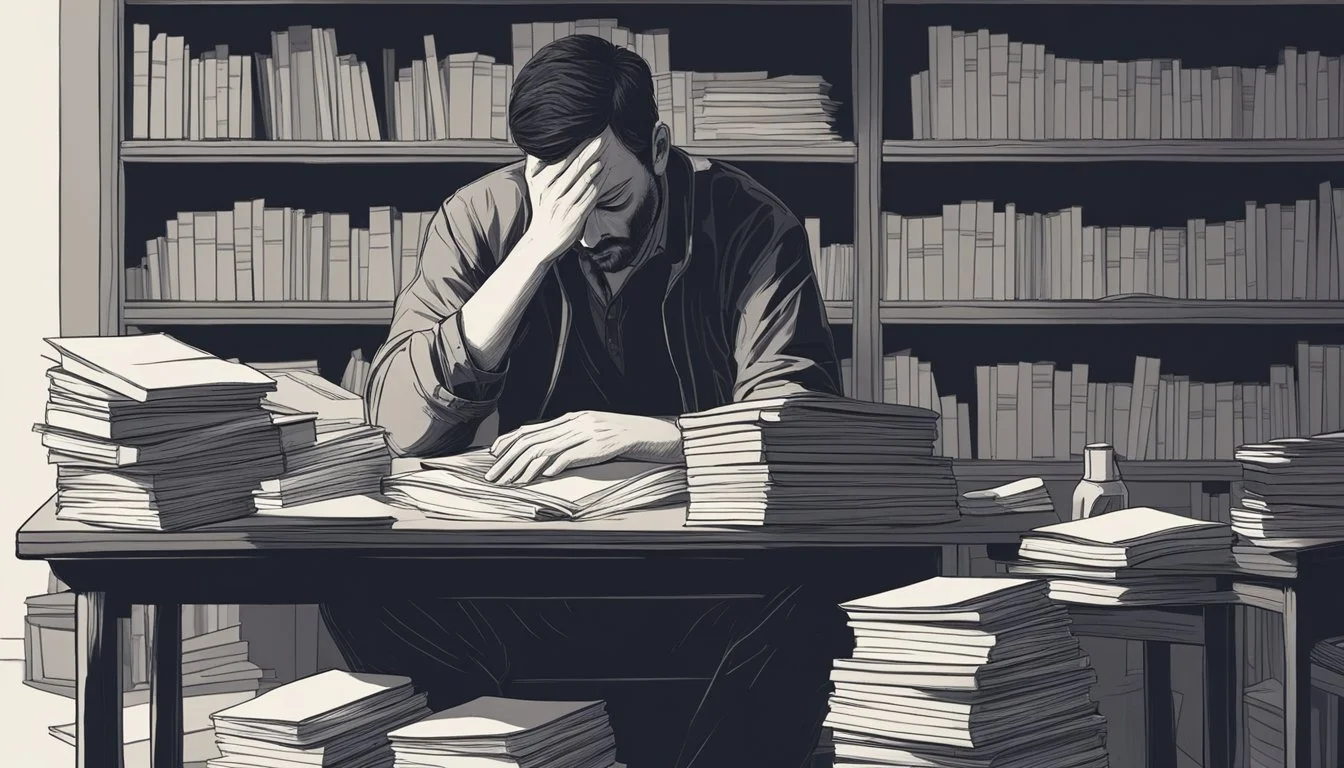The Silent President's Silent Struggle: Calvin Coolidge's Battle with Depression
A Hidden Chapter in American History
Calvin Coolidge, known as "Silent Cal" for his taciturn nature, served as the 30th President of the United States during the Roaring Twenties. While his presidency is often associated with economic prosperity and limited government intervention, a lesser-known aspect of Coolidge's life was his personal struggle with depression.
Despite his public image of stoic composure, Coolidge grappled with intense feelings of grief and melancholy, particularly after the death of his young son Calvin Jr. in 1924. This tragic loss had a profound impact on the president, affecting both his personal life and his approach to governance. Coolidge's battle with depression offers a unique lens through which to examine his presidency and the man behind the reserved facade.
Coolidge's quiet demeanor and preference for brevity in speech may have masked his inner turmoil. His struggle with depression provides insight into the challenges faced by public figures who must maintain a composed exterior while dealing with personal hardships. Understanding this aspect of Coolidge's life adds depth to our perception of his presidency and the complexities of leadership during times of personal crisis.
The Rise of Calvin Coolidge
Calvin Coolidge's journey from a small Vermont village to the White House was marked by steady progression through public service roles. His rise exemplified the power of persistence, principle, and pragmatism in American politics.
Early Life and Education
Born on July 4, 1872, in Plymouth Notch, Vermont, John Calvin Coolidge grew up in a modest household. His father, a farmer and shopkeeper, instilled in him values of frugality and hard work.
Coolidge attended local schools before enrolling at Amherst College in Massachusetts. At Amherst, he honed his analytical skills and developed a keen interest in public speaking and debate.
He graduated cum laude in 1895, demonstrating academic excellence that would serve him well in his future career.
From Massachusetts Law to Public Service
After college, Coolidge apprenticed at a law firm in Northampton, Massachusetts. He passed the bar exam in 1897 and opened his own practice.
Coolidge's political career began in 1898 when he was elected to the Northampton City Council. He climbed the political ladder steadily:
1907: Elected to Massachusetts House of Representatives
1912: Became mayor of Northampton
1914: Elected to Massachusetts State Senate
1916: Chosen as President of the State Senate
His reputation for integrity and fiscal conservatism grew with each role.
The Road to the Presidency
Coolidge's national profile rose significantly when he was elected Governor of Massachusetts in 1918. His handling of the Boston Police Strike in 1919 catapulted him to national attention.
The Republican Party recognized Coolidge's potential and selected him as Warren Harding's running mate in the 1920 presidential election. They won decisively.
As Vice President, Coolidge maintained a low profile. However, Harding's sudden death on August 2, 1923, thrust him into the presidency.
Coolidge took the oath of office by lamplight at his family home in Vermont, a moment that captured the nation's imagination.
Coolidge's Economic Vision
Calvin Coolidge championed limited government and fiscal conservatism during his presidency. His economic policies focused on reducing taxes, cutting federal spending, and promoting business growth.
Taxation and Government Spending
Coolidge implemented significant tax cuts during his tenure. He worked with Treasury Secretary Andrew Mellon to reduce income tax rates across all brackets. The top marginal rate dropped from 73% to 24%.
Coolidge also slashed federal spending. He vetoed numerous bills he deemed excessive and pushed for budget cuts in various departments. This approach allowed him to reduce the national debt by about 30% during his presidency.
The administration's fiscal policies aimed to stimulate economic growth by leaving more money in citizens' and businesses' hands. Coolidge believed this would lead to increased investment and productivity.
Promoting Economic Prosperity
Under Coolidge's leadership, the United States experienced a period of economic boom known as the "Roaring Twenties." His hands-off approach to business regulation fostered a pro-growth environment.
Coolidge supported policies that encouraged technological innovation and industrial expansion. He promoted the development of new industries such as radio and aviation.
The stock market soared during this period, with the Dow Jones Industrial Average quadrupling in value. Per capita income rose by about 30%, and unemployment remained low.
Response to Farmers' Issues
While much of the country prospered, farmers faced significant challenges. Coolidge's response to agricultural issues was limited, adhering to his belief in minimal government intervention.
He vetoed the McNary-Haugen Farm Relief Bill twice. This legislation aimed to support farmers by establishing a federal agency to buy surplus crops at guaranteed prices.
Coolidge argued that such measures would encourage overproduction and harm the economy in the long run. He preferred to let market forces correct agricultural issues, a stance that drew criticism from farming communities.
Presidential Policies and Influence
Calvin Coolidge's presidency during the Roaring Twenties was marked by significant domestic and foreign policy decisions. His conservative approach shaped America's economic landscape and international relations.
Domestic Affairs and Legislation
Coolidge championed pro-business economic policies that fueled the prosperity of the 1920s. He supported tax cuts, reduced government spending, and limited regulation. These measures encouraged economic growth and a booming stock market.
The Immigration Act of 1924 was a key piece of legislation during Coolidge's tenure. It established strict quotas on immigration, particularly from Southern and Eastern Europe.
Coolidge's hands-off approach to governance earned him the nickname "Silent Cal." He believed in limited federal intervention and vetoed several bills he deemed unnecessary.
Coolidge's Foreign Policy Stance
Coolidge favored isolationism and non-intervention in foreign affairs. He supported the Dawes Plan to help stabilize Europe's post-war economy without direct U.S. involvement.
The Kellogg-Briand Pact, signed in 1928, was a notable foreign policy achievement. This international agreement aimed to outlaw war as an instrument of national policy.
Coolidge's administration focused on promoting American business interests abroad rather than political entanglements.
Cultural and Social Impacts
The Coolidge era saw significant cultural shifts. The president's reserved demeanor contrasted sharply with the exuberance of the Roaring Twenties.
Coolidge embraced new technologies, becoming the first president to make regular radio addresses to the nation. This helped shape modern political communication.
His presidency coincided with changing social norms, including women's suffrage and the rise of consumer culture. While not actively promoting these changes, Coolidge's policies created an environment where they could flourish.
The Silent President's Personal Battles
Calvin Coolidge faced private struggles that contrasted sharply with his public persona. His stoic demeanor masked internal turmoil and mental health challenges.
Calvin Coolidge and Mental Health
Calvin Coolidge battled depression throughout his life. The death of his son Calvin Jr. in 1924 deeply affected him, exacerbating his tendency toward melancholy. Coolidge wrote, "When he went, the power and the glory of the Presidency went with him."
Despite his struggles, Coolidge maintained his duties as president. He rarely discussed his mental state publicly, adhering to the social norms of his era. His wife Grace played a crucial role in supporting him during difficult times.
Coolidge's depression likely contributed to his decision not to seek re-election in 1928. He felt drained by the presidency and longed for a quieter life.
Private Life vs. Public Image
Coolidge's public image as "Silent Cal" differed significantly from his private self. While known for his brevity in public, he was more talkative at home. His wife Grace once said, "I have to force him to go out and run for president. But I have to force him to come in and eat his meals."
His frugality and work ethic were genuine traits, evident in both his public and private life. Coolidge rose early, worked long hours, and maintained a strict schedule. He believed in leading by example, demonstrating integrity in his personal and professional conduct.
Despite his inner turmoil, Coolidge maintained a composed public image. This careful separation of public and private personas was a hallmark of his presidency.
Coolidge's Legacy and Historical Evaluation
Calvin Coolidge's presidency left a complex legacy that continues to spark debate among historians and political analysts. His approach to governance and economic policies had far-reaching consequences that shaped America's trajectory in the years following his tenure.
Assessing the Coolidge Era
The 1920s, often called the "Roaring Twenties," saw unprecedented economic growth and prosperity under Coolidge's leadership. His administration championed low taxes, reduced government spending, and a hands-off approach to business regulation. This period witnessed a surge in consumer spending, technological advancements, and cultural shifts.
Coolidge's fiscal conservatism resulted in budget surpluses and a reduction of the national debt. His famous quote, "The chief business of the American people is business," encapsulated his pro-business stance.
However, critics argue that Coolidge's policies exacerbated income inequality and contributed to economic instability.
The Onset of the Great Depression
The stock market crash of 1929, occurring shortly after Coolidge left office, marked the beginning of the Great Depression. While Coolidge cannot be solely blamed for this economic catastrophe, some historians argue that his policies played a role in setting the stage for the downturn.
Coolidge's reluctance to regulate Wall Street and his administration's failure to address underlying economic weaknesses have been cited as contributing factors. The laissez-faire approach, once celebrated, came under intense scrutiny as the nation plunged into economic turmoil.
Long-Term Effects on American Policies
Coolidge's presidency had lasting impacts on American governance:
Fiscal conservatism: His emphasis on balanced budgets influenced future Republican economic policies.
Limited government: Coolidge's belief in minimal federal intervention shaped conservative ideology.
Tax policy: His tax cuts set a precedent for future debates on taxation and economic growth.
These ideas continued to resonate in American politics, particularly during the Reagan administration in the 1980s, which drew inspiration from Coolidge's approach.
Reflecting on Coolidge's Place in History
Coolidge's historical reputation has fluctuated over time. Initially overshadowed by the Great Depression, his presidency has been reevaluated in recent decades. Some view him as a principled leader who maintained stability and prosperity, while others criticize his passivity in the face of looming economic troubles.
The Calvin Coolidge Presidential Foundation works to preserve his legacy, highlighting his commitment to public service and fiscal responsibility. Historians like Amity Shlaes have reassessed Coolidge's presidency, arguing for a more nuanced understanding of his era and policies.
Coolidge's unique leadership style, marked by his famous reticence, continues to intrigue scholars and the public alike. His presidency serves as a case study in the long-term effects of economic policies and the challenges of governance in a rapidly changing world.





